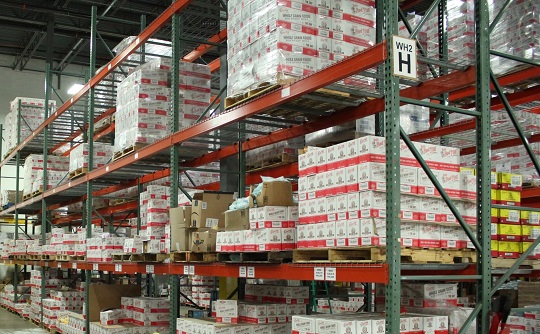It’s very important for the success of your business that you know what you keep and how much of it. If you know this information, you can make better business plans and decisions, like when to buy more items, how many, or when to start making new lots. To do this, you need information about the stock you keep. You need to do stocktaking, which means counting the things you have.
Taking stock, or stock taking, or a few other names, is the process of physically counting your inventory and then making changes, if necessary, to your inventory records based on what you found.
This activity is important because the results of this stocktaking will be used as the basis for many things, as I’ve already said. You must do it right if you want to be sure that the calculations you do are correct.
What to do?
In this post, we’ll talk about that.
But before you do that, make sure you’re also part of the scmguide telegram channel, where I share many more tips about supply chain management.
Table of Contents
6 effective stocktaking steps for more accurate results
There are a few steps you should take to make sure your stocktaking is accurate and quick.
Let’s take each one in turn.
Arrange materials neatly
Keeping things in a neat order will make it easier and faster to count your inventory.
Stack your inventory box by box or bag by bag, depending on how it’s packed, based on your standard stack. For example, the standard way to stack 60 boxes on a pallet is with a length of 4 boxes, a width of 3 boxes, and a height of 5 boxes. When figuring out how much inventory you need, make sure that all of your boxes are stacked the same way.

With the number of boxes on a pallet being standardized at 60, you can easily do the math by counting the number of pallets and then multiplying by 60. Also, if you know how much material is in each box, you can multiply the number of boxes by how much material is in each box to get the total number of pieces in your inventory.
When you have put all the boxes in a standard order, it will be easy to see if any of the pallets are not complete. You don’t have to figure out how many boxes go on each pallet. All you have to do is look at how the boxes in the palette are set up and see if it matches the standard (visual control).
And it will be much better if you keep the boxes/pallets in this order all the time, not just during the stocktaking process. That will make it easier for you to keep track of what you have every day.
Separate inventory and non-inventory
If you have a bunch of things that aren’t in your inventory records, like materials for samples, put them in different piles. Don’t mix it up with the other things you have.
So, you won’t end up with too much or too little of these materials. You don’t want your calculations to come out higher than what you wrote down because you counted things you shouldn’t have.
So, you have to keep these two kinds of things apart. Put each piece of material in the place you’ve chosen and standardized. If it gets mixed up, it will be hard to get accurate results from your stocktaking.
You might also like:
- What is a Warehouse, and Why is it Important in the Supply Chain?
- 9 of the Most Common Reasons Why You Might Have Excess Stock
Count twice or more
There may be mistakes in the counting process. Every time a counter does a calculation, you must check that the result is correct. Has the counting been done right and correctly, or not?

How do you check that this counting process is correct?
At least two counters should be given to each material. Ask them to count the same things at different times (not at the same time).
In this way, you will get two results when you do the counting. Then, you compare the counting result between counters 1 and 2. If the numbers come out the same, you can say that the counting was done right.
If there’s a difference?
Do the third count that the two counters will do together.
This method will make sure that the counting are correct.
Use stocktaking slips
Use stocktaking slips to keep track of the things you’ve counted.
Make this slip in two copies. The original slip will be pasted on the calculated material, and the copy will be given to the admin to be put into the stocktaking report.
You have to keep this stocktaking slip in order. Give each slip of paper a serial number and write it down. Make sure you give out and return the same number of stocktaking slips. Nobody can lose a slip.
Another rule is that the stocktaking slip should not have any scribbles on it. If you make a mistake, you need to get a new slip, but you still need to give the wrong slip to the admin.
Make the stocktaking slip and fill it out with information about the item code, name, stock location, and other things. Don’t write anything in the Material Quantity column. This is what the counter will show when the counting is done.
You can also give out a “blank” stocktaking slip that hasn’t been filled out with any information to see if anything is being kept outside of the actual stock location.
Use the how to count slip
Those of you who are in your warehouse every day will find it very easy to count your stock one piece at a time. But what about people from outside your company who are sent to check your stock? They won’t know what kinds of things you store, of course.
Because of this, it would be best to attach a counting slip to your things in addition to the stocktaking slip I told you about earlier.

What does it do?
The content tells you how to count how much inventory you have.
For example, a box is how you package your inventory. Following the first steps above, you have set it up in a standard way. Let’s say the arrangement is 4 x 6 x 6 boxes, which equals 144 boxes. Each box could hold up to 10 pieces. This means that you have 1440 pieces in stock.
Length x Width x Height = Total should be written in an empty column on your counting sheet. The counter will then fill them based on how the other boxes are set up. Don’t forget to leave a column blank for the number of items per box and the total number of items in pcs.
Also, make a separate column for any boxes that don’t fit in the normal pallet arrangement. For instance, there is a pallet with only 9 boxes on it. So, the counter will fill 9 boxes in this last column. So, 144 boxes plus 9 boxes equals 153 boxes (1530 pcs).
With this counting slip, anyone can easily figure out how to count the inventory. This will make it easier for both internal and external auditors to check the counters’ results.
Also, make sure everyone on your team who is in charge of counting inventory knows how to fill out the slip.
You might also like:
Do an audit
Whenever you do a stocktake, you will need a function to check the results of the inventory counting. Because of this, you should give this validation task to a team of both internal and external auditors.
What gets checked?
Everything, including the process for counting inventory, how to count it, and a lot more.
In this way, you can be sure that the counting are correct.
Why is the accuracy of stocktaking results important?
As I said before, the results of this stocktaking will be used for a lot of business planning and decision making. So, this becomes a very important point.
And the most important part of a stocktaking or inventory counting is not how well the results of the counting match the existing records of the inventory. That isn’t what matters.
The most important part of a stocktaking is to make sure that the counting are as accurate as possible based on the actual inventory. No matter what your inventory records say, that’s the most important thing.
And that’s the difference: to fix something later, you have to figure out what went wrong. Did the mistake happen with the way you keep track of your warehouse’s inventory or with the way you record it? Or is there a problem with your Warehouse or Inventory Management System?
Errors can happen if you make a mistake when entering the parameters at the beginning of each item.
After you’ve found the cause of the problem, you’ll need to do stock adjustments to make sure that the physical inventory and the numbers in the system match up.
If your analysis does take a long time, you can make an inventory change right away because the planning function in your organization will need the data very much. Don’t fix anything or make any changes to your stock until you’ve found the real cause.
And as part of getting ready for the stocktaking, put together a team and make a schedule of the activity, from getting ready to the stocktaking itself, to adjusting the stock and closing. This includes cut-offs for inventory transactions so that they don’t mess up the math.
And finally, take stock of your business on a regular basis. This could be once a month, every three months, every semester, or once a year, depending on your needs.
Conclusion
Stocktaking is one of the most important things you should do to keep your business running smoothly.
The most important part of stocktaking, or counting inventory, is that the results of these calculations are correct based on the actual inventory, not on records. This is the way of thinking that everyone involved in this project needs to have.
Stocktaking will be easier and faster if you can keep your goods in the warehouse in the same order every day. This is one of the things you need to do to get ready for the stocktaking process.
And if you want accurate stocktaking results, you can do all of the above steps at once. This will make it easier for you to do this stocktaking task well.
Hope it helps!
If you think this article is helpful, send it to your friends so they can also benefit from it. You can also join the scmguide telegram channel to learn more about supply chain management and stay up to date on the latest posts to this blog. You don’t have to give credit if you use any of the articles on this blog for your own purposes, even if they are for profit.
 by
by 

